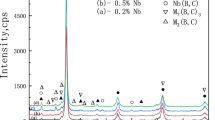Abstract
Fine grained iron containing 600 ppm oxygen is fairly brittle below room temperature. The brittleness essentially comes from the difficulty for the Lüders band to initiate and propagate in fine grained specimens at the required velocity and fracture occurs in the severely strained region within and near the band front, before deformation propagates through a specimen.
Pressurization at several thousand atmospheres, which introduces free dislocations into a specimen, removes the brittleness and increases the elongation at low temperatures. It is shown that the pressure-induced dislocations modify the stress dependence of the band velocity and increase the band velocity at a given stress.
Résumé
Le fer à grain fin contenant 600 pprn d'oxygène est relativement fragile en dessous de la température ambiante. Cette fragilité procède essentiellement des difficultés de formation et de propagation des bandes de Lüders aux vitesses requises dans des éprouvettes à grain fin; la rupture survient dans une région sévèrement sollicitée qui se trouve au sein d'une bande ou au voisinage du front de celle-ci, et avant qu'une déformation puisse s'étendre à l'ensemble de l'éprouvette.
Si l'on soumet cette éprouvette à une pressurisation de plusieurs milliers d'atmosphères, on y introduit des dislocations libres, qui ont pour effet de restituer une ductilité et d'accroitre l'allongement à dasse température.
On montre que les dislocations introduites par une pressurisation ont pour effet de modifier la relation qui lie la vitesse de propagation des bandes de Lüders et l'état de tension, et en particulier d'accroître cette vitesse à tension donnée.
Zusammenfassung
Fein graniertes Eisen, welches 600 ppm Sauerstoff enthält ist bei einer Temperatur die niedriger ist als Raumtemperatur ziemlich spröde. Die Sprödigkeit entsteht hauptsächlich durch die Schwierigkeit des Lüderschen Treibriemens sich bei fein granierten Proben mit der vorgeschriebenen Geschwindigkeit zu dehnen und auszubreiten. Ein Bruch entsteht in dem stark angespannten Gebiet in und um den vorderen Teil des Treibriemens bevor Formveränderung durch die Probe erzeugt wird. Druck mit einigen tausend Atmosphären, welcher freie Verschiebungen in einer Probe einleitet, entfernt die Sprödigkeit und erhöht die Ausdehnung bei niedrigen Temperaturen. Es wurde gezeigt, daß die durch. Druck verursachten Verschiebungen die Anspannungsabhängigkeit der Treibriemengeschwindigkeit modifizieren und die Treibriemengeschwindigkeit bei einer gegebenen Anspannung erhöhen.
Similar content being viewed by others
References
S. Sakui and T. Mori, Proceedings of the 1st Inter. Conf. on Fracture, (1965) p, 1069, Sendai, Japan.
J. C. Fisher and H. C. Rogers, Acta Met., 4 (1965) 180.
J. F. Butler, J. Mech. Phys. Solids, 10 (1962) 313.
M. Yajima and M. Ishii, Acto Met., 15 (1967) 651.
M. Yajima and M. Ishii, Trans. Iron and Steel Inst. Japan, 7 (1967) 45.
H. Suzuki, The Relation between the Structure and Mechanical Properties of Metals, HMSO (1963) p. 518.
M. Yajima and M. Ishii, Trans. Iron and Steel Inst. Japan, 8 (1968) 34.
S. V. Radcliffe and H. Warlimont, Physica Status Solidi, 7 (1964) 67.
R. I. Garrod and H. L. Wain, J. Less Common Metals, 9 (1965) 81.
M. Yajima and M. Ishii, Proc. Inter. Conf on the Strength of Metals and Alloys, in press, Japan Inst. Metals, Tokyo, Japan, (1967).
G. T. Hahn, Acta Met., 10 (1962) 727.
W. S. Owen, B. L. Averbach and M. Cohen, Trans. AIME., 50 (1958) 634.
D. B. C. Taylor and L. E. Melvern, Response of Metals to High Velocity Deformation, (1961) p. 77, Interscience Pub., New York.
J. J. Gilman, J. Appl. Phys., 36 (1965) 3195.
W. G. Johnston and J. J. Gilman, J. Appl. Phys., 30 (1959) 129.
E. W. Hart, Acta Met., 3 (1955) 146.
Author information
Authors and Affiliations
Rights and permissions
About this article
Cite this article
Yajima, M., Ishii, M. The effect of pressurization on the pseudo-brittleness in an iron oxygen alloy. Int J Fract 5, 1–8 (1969). https://doi.org/10.1007/BF00189932
Received:
Revised:
Issue Date:
DOI: https://doi.org/10.1007/BF00189932



